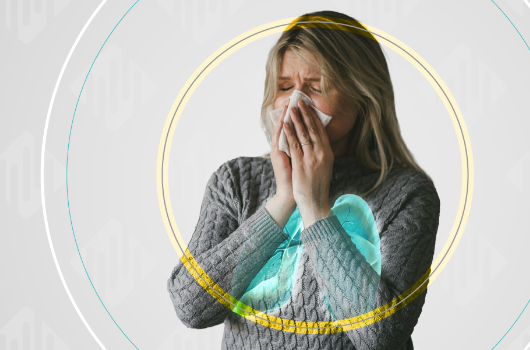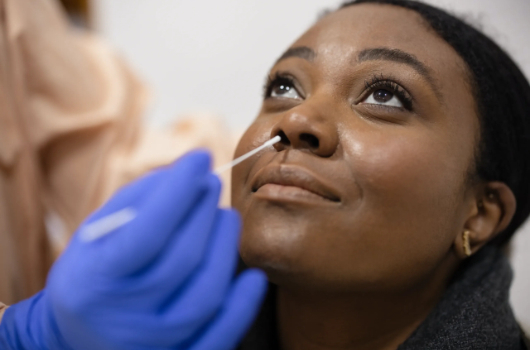Clinical Study
Healthcare Utilization and Costs Following Molecular Diagnostic Testing among Patients with Vaginitis

Dr. Azia Evans, Dr. Steven Goldberg, Dr. Maren Fragala, Dr. Jay Reddy • Jan. 16, 2025
Key Summary of Published Article – Healthcare Utilization and Costs Following Molecular Diagnostic Testing among Patients with Vaginitis
A new study published in the Journal of Comparative Effectiveness Research demonstrates that when patient groups are similar, the use of next-day polymerase chain reaction (PCR) testing for patients with vaginitis reduces healthcare use and saves on follow-up costs. This study assessed the healthcare utilization of patients with a diagnosis or symptoms of vaginitis using the PharMetrics® Plus database. Patients in this study received either a HealthTrackRx syndromic vaginitis PCR test, an alternate commercially available PCR test, or no diagnostic test at the initial provider visit. All patients enrolled in this study were matched on age, risk, and relevant clinical variables to ensure that healthcare use and cost reductions were not attributable to unmatched populations.
Patients who received a HealthTrackRx syndromic vaginitis test had the lowest healthcare use and cost during the 6-month follow-up period compared to those who received another PCR test o r no test. Patients who received an alternate PCR test had similar, though statistically higher follow-up costs, while patients who received no diagnostic testing had the highest healthcare use and cost during the follow-up period.
The Problem
Vaginitis is a common condition affecting women throughout their lives but is particularly prevalent in reproductive-age women. Vaginitis can have several distinct etiologies; however, symptom presentation can often be similar across the various infectious causes. Previous research has shown that diagnosis on clinical presentation alone has a high rate of inaccurate diagnosis, with over 40% of women receiving inaccurate treatment.1 This ultimately contributes to a high rate of recurrence and repeat office visits for patients with vaginitis.
The Solution
PCR diagnostic testing has demonstrated an ability to provide accurate results faster than other traditional methods like culture. It has the specific advantage of being able to identify multiple organism types from a single laboratory test. This has contributed to the increased adoption of PCR technology in outpatient medicine. Despite these clinical advantages, until recently there has been limited data to demonstrate PCR diagnostics’ positive impact on follow-up healthcare use.
The Study
This study evaluated healthcare utilization and costs of women who received a syndromic, next-day PCR test for vaginitis compared to patients who had no diagnostic tests or alternative PCR test.
Total and service-specific healthcare resource utilization and costs were assessed over 6 months. Results show that women who received a syndromic, next-day PCR test had significantly fewer outpatient medical services in the 6 months following initial diagnosis than those who received no diagnostic test (an average of 18 services compared to 21 services). Women who received a syndromic, next-day PCR test also had lower healthcare costs during this time, averaging $6,675, compared to an average of $8,742 in the group who received no test (likely due to having more other medical services during the follow-up period).
Conclusion
The use of syndromic multiplex PCR diagnostics with next-day results in patients with vaginitis is associated with lower outpatient and total healthcare costs than patients who received no diagnostic testing. These findings indicate that syndromic multiplex PCR diagnostics may improve patient management compared with clinical diagnosis alone.
1. Hillier, S. L., et al. (2021). “Diagnosis and Treatment of Vaginal Discharge Syndromes in Community Practice Settings.” Clinical Infectious Diseases 72(9): 1538-1543.
Related Articles and White papers

Dr. Azia Evans, Dr. Steven Goldberg, Dr. Maren Fragala, Dr. Jay Reddy • Jan. 16, 2025
Key Summary of Published Article – Healthcare Utilization and Costs Following Molecular Diagnostic Testing among Patients with Vaginitis
A new study published in the Journal of Comparative Effectiveness Research demonstrates that when patient groups are similar, the use of next-day polymerase chain reaction (PCR) testing for patients with vaginitis reduces healthcare use and saves on follow-up costs. This study assessed the healthcare utilization of patients with a diagnosis or symptoms of vaginitis using the PharMetrics® Plus database. Patients in this study received either a HealthTrackRx syndromic vaginitis PCR test, an alternate commercially available PCR test, or no diagnostic test at the initial provider visit. All patients enrolled in this study were matched on age, risk, and relevant clinical variables to ensure that healthcare use and cost reductions were not attributable to unmatched populations.
Patients who received a HealthTrackRx syndromic vaginitis test had the lowest healthcare use and cost during the 6-month follow-up period compared to those who received another PCR test o r no test. Patients who received an alternate PCR test had similar, though statistically higher follow-up costs, while patients who received no diagnostic testing had the highest healthcare use and cost during the follow-up period.
The Problem
Vaginitis is a common condition affecting women throughout their lives but is particularly prevalent in reproductive-age women. Vaginitis can have several distinct etiologies; however, symptom presentation can often be similar across the various infectious causes. Previous research has shown that diagnosis on clinical presentation alone has a high rate of inaccurate diagnosis, with over 40% of women receiving inaccurate treatment.1 This ultimately contributes to a high rate of recurrence and repeat office visits for patients with vaginitis.
The Solution
PCR diagnostic testing has demonstrated an ability to provide accurate results faster than other traditional methods like culture. It has the specific advantage of being able to identify multiple organism types from a single laboratory test. This has contributed to the increased adoption of PCR technology in outpatient medicine. Despite these clinical advantages, until recently there has been limited data to demonstrate PCR diagnostics’ positive impact on follow-up healthcare use.
The Study
This study evaluated healthcare utilization and costs of women who received a syndromic, next-day PCR test for vaginitis compared to patients who had no diagnostic tests or alternative PCR test.
Total and service-specific healthcare resource utilization and costs were assessed over 6 months. Results show that women who received a syndromic, next-day PCR test had significantly fewer outpatient medical services in the 6 months following initial diagnosis than those who received no diagnostic test (an average of 18 services compared to 21 services). Women who received a syndromic, next-day PCR test also had lower healthcare costs during this time, averaging $6,675, compared to an average of $8,742 in the group who received no test (likely due to having more other medical services during the follow-up period).
Conclusion
The use of syndromic multiplex PCR diagnostics with next-day results in patients with vaginitis is associated with lower outpatient and total healthcare costs than patients who received no diagnostic testing. These findings indicate that syndromic multiplex PCR diagnostics may improve patient management compared with clinical diagnosis alone.
1. Hillier, S. L., et al. (2021). “Diagnosis and Treatment of Vaginal Discharge Syndromes in Community Practice Settings.” Clinical Infectious Diseases 72(9): 1538-1543.





